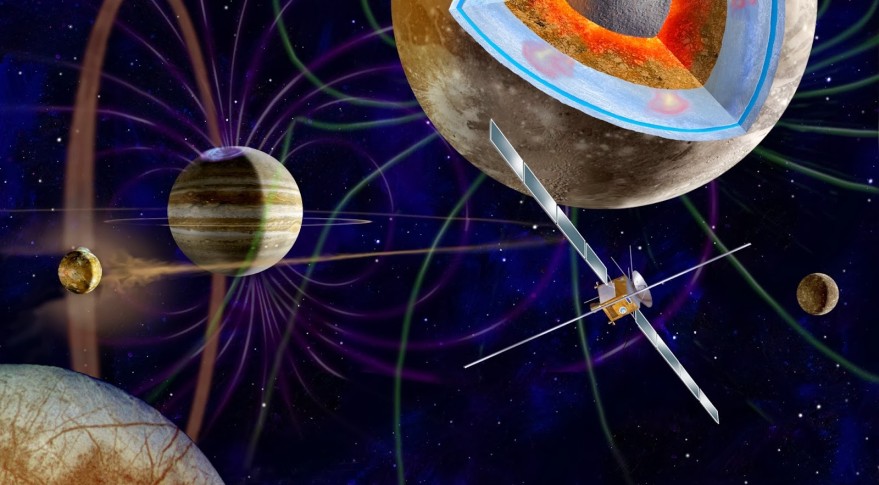Europe's Jupiter Explorer Mission Moves to Prototype Production

LONDON — The European Space Agency completed the preliminary design review for the Jupiter Icy Moon Explorer , giving a go-ahead to prime contractor Airbus and its partners to start building a prototype spacecraft to test systems for the challenging mission known simply as Juice.
The 1.5 billion-euro ($1.62 billion) mission — expected to launch on its seven-year journey in 2022 — is Europe's first shot at exploring the solar system's largest planet and its moons at close quarters. Giuseppe Sarri, ESA's Juice project manager, said the 22-member space agency has never attempted a mission of this difficulty and complexity.
"Juice is certainly a step forward for ESA," Sarri said. "To get to Jupiter, we will have to perform five flybys, which is something we haven't done before. The environment around Jupiter is extremely harsh and we would have to make sure the spacecraft's electronics are properly protected from the extremely high radiation, otherwise the computers could be dead in two weeks."
ESA will contribute 940 million euros (in 2014 terms) towards the overall budget of the mission, covering the construction of the spacecraft, an Ariane 5 launch, the operations and scientific ground segment, as well as the actual running of the mission. The mission's 10 scientific instruments, including cameras, an ice-penetrating radar, an altimeter, radio-science experiments, and sensors to monitor the magnetic field, will be paid for by the national space agencies of ESA's member states.
"There is a large involvement of the Italian Space Agency, which will deliver three instruments and contribute to a fourth one," Sarri said. "Germany and Sweden are both responsible for two instruments. France and the UK will deliver one instrument each."
More than 60 companies will be involved in building components for the spacecraft, all of which have now been selected.
Get the Space.com Newsletter
Breaking space news, the latest updates on rocket launches, skywatching events and more!
Juice's 100-square-meter solar array, the largest to ever be flown by Europe, will be made by Germany's Azur Space, which has previously developed solar cells for the Rosetta, Venus Express and Mars Express probes and the Hubble Space Telescope.
"The availability of energy is a massive challenge," said Sarri. "The illumination in the orbit around Jupiter is 25-times lower than what we have in the orbit around Earth, so even with this massive solar cell we will only collect about 820 watts."
The high-energy electrons, protons and heavy ions drawn towards Jupiter by its powerful gravitational force, as well as magnetic field, will put an extreme strain on the solar array. ESA hopes to start testing the technology by the end of this year to understand the degradation processes that will inevitably affect the solar array's performance.
In addition to gathering data about Jupiter's atmosphere and magnetosphere, Juice will also take a close look at three of the planet's largest moons: Ganymede, Callisto and Europa. The spacecraft will perform about 20 flybys of Jupiter's moons and eventually enter the orbit around Ganymede to search for signs of liquid water underneath the moon's thick icy crust.
"The idea of the mission is to see whether these moons have an environment, which could sustain life," explained Sarri. "The Juice spacecraft will carry instruments to measure the thickness of the ice to see whether there is a transition to liquid. It will measure the magnetic field, which will also tell us whether the liquid is conductive."
ESA, which kicked off the Juice project in July 2015, hopes to have the prototype, or engineering model, ready by the end of 2018. Tests of the prototype including instruments are scheduled for 2019, after which manufacturing of the flight model will commence.
The 5.3-ton Juice is expected to launch in 2022 with an anticipated arrival to the Jovian system in 2029. The explorer will spend three and a half years surveying the distant worlds, eight months of which will be dedicated to the exploration Ganymede. Juice will launch at about the same time as NASA's Europa Clipper mission, currently under development, which aims to dispatch a lander to Europa during one of its multiple flybys around the moon. Funding for the lander, however, was omitted from the White House budget blueprint released March 16.
This story was provided by SpaceNews, dedicated to covering all aspects of the space industry.
Join our Space Forums to keep talking space on the latest missions, night sky and more! And if you have a news tip, correction or comment, let us know at: community@space.com.

Tereza is a London-based science and technology journalist, aspiring fiction writer and amateur gymnast. Originally from Prague, the Czech Republic, she spent the first seven years of her career working as a reporter, script-writer and presenter for various TV programmes of the Czech Public Service Television. She later took a career break to pursue further education and added a Master's in Science from the International Space University, France, to her Bachelor's in Journalism and Master's in Cultural Anthropology from Prague's Charles University. She worked as a reporter at the Engineering and Technology magazine, freelanced for a range of publications including Live Science, Space.com, Professional Engineering, Via Satellite and Space News and served as a maternity cover science editor at the European Space Agency.











